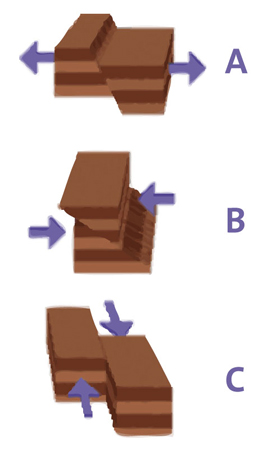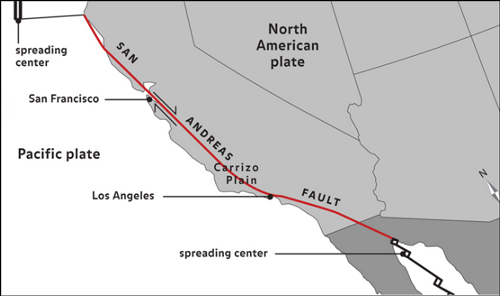Changes to the Surface of the Earth
Convection currents in the magma drive plate tectonics.

Heat generated from the radioactive decay of elements deep in the interior of the Earth creates magma (molten rock) in the aesthenosphere.
|
The aesthenosphere (70 ~ 250 km) is part of the mantle, the middle sphere of the Earth that extends to 2900 km. It contrasts with the more rigid lithosphere, the outer shell of the Earth (0 ~ 70 km) that contains the continental crust (made up of less dense granitic rocks) and the oceanic crust (more dense basaltic rocks) that are broken up into more than a dozen rigid plates.
|
 |
Large convection currents in the aesthenosphere transfer heat to the surface, where plumes of less dense magma break apart the plates at the spreading centers, creating divergent plate boundaries.
As the plates move away from the spreading centers, they cool, and the higher density basalt rocks that make up ocean crust get consumed at the ocean trenches/subduction zones. The crust is recycled back into the aesthenosphere.
Subduction of Plates
 |
Because ocean plates are denser than continental plates, when these two types of plates converge, the ocean plates are subducted beneath the continental plates. Subduction zones and trenches are convergent margins. The collision of plates is often accompanied by earthquakes and volcanoes. |
We cannot see the deep interior of Earth, but we know from a variety of observations that it is in continuous motion. This is because the mantle convects. This fundamental planetary process has profoundly influenced the character and evolution of Earth.
Convection is the process by which less dense material rises and more dense material sinks. The former are said to be more “buoyant” than the latter, and the vertical forces due to density difference are referred to as buoyancy forces. Rocks, water, and air—indeed, most materials—expand and thus become less dense as temperature increases, so convection is typically driven by temperature differences. In Earth’s mantle hot rock rises and slightly cooler rock sinks.
Convection drives our dynamic planet. The planet’s liquid outer core convects, creating the Earth’s magnetic field; the ocean convects, enabling exchange of CO2 with the atmosphere and transporting nutrients from depth that support important fisheries; and the atmosphere convects, acting in concert with the ocean to transport heat and moisture around the planet to create climate.
How Does the Mantle Convect?
Everyday examples of convection in liquids include lava lamps or water heating on a stove. But the mantle is, in general, solid. It turns out that rocks, along with most other solids, flow by a solid-state, creeping motion, especially when they are hot and given enough time. This is what happens in the mantle. Based on observations of the rates at which the surface of Earth moves, geologists estimate the mantle convectively flows at rates of several centimeters a year.
The heat driving mantle convection has three sources. “Primordial” heat (left over from the accretion and differentiation that led to the formation of Earth’s core) contributes 20 to 50% of the heat. Heating due to the decay of radioactive isotopes (mainly potassium, thorium, and uranium) contributes 50 to 80%. Thirdly, tidal friction from the Moon’s pull on the Earth contributes perhaps 10%. Mantle convection is the main mechanism by which this heat escapes from the interior of Earth.
How is Mantle Convection Related to Plate Tectonics?
Plate tectonics refers to the movement of the rigid plates around the surface of Earth. The outer portion of the planet, or lithosphere, is relatively rigid because it is relatively cold. The lithosphere varies in thickness but is typically a hundred or so kilometers thick. It includes the upper mantle and both the continental and oceanic crust. The mantle’s convective motions break the lithosphere into plates and move them around the surface of the planet. These plates may move away from, move by, or collide with each other. This process forms ocean basins, shifts continents, and pushes up mountains.
Tectonic plates break apart and diverge where the mantle beneath is upwelling. In such regions mid-ocean ridges develop, and new lithosphere and crust form to replace the material that is moving away. Where plates converge, usually where the mantle is downwelling, one plate is forced beneath another. When this involves plates with embedded continental crust, mountain belts such as the Alps and Himalayas form. If the collision involves plates with oceanic crust, subduction zones form where one plate descends into the mantle beneath the other plate. Above these subduction zone chains of volcanoes and island arcs like the Aleutians, develop.
Where plates move by each other, enormous fault systems form. Hundreds to thousands of kilometers long, these fault systems are responsible for many of the world’s earthquakes, which occur when a fault ruptures and the accumulated strain is abruptly released. California’s San Andreas fault system is an example. So mantle convection not only accounts for ocean basins, continents, and mountains, it is also the ultimate reason for nearly all earthquakes and volcanoes.
Mantle Convection and Interconnections Between Different Earth Systems
The churning of the mantle also affects the chemical composition of the ocean and has a long-term influence on climate. Mantle convection is the main way heat from Earth’s interior is transported to its surface, and this heat escapes principally through mid-ocean ridges. In fact, the connected mid-ocean ridge system is in essence a 80,000 km long volcano. Escaping heat along these ridges causes hot water to circulate through the crust in a “hydrothermal system.” As seawater reacts with the hot rocks, its composition changes. Over the course of several million years, all of the water in the world’s oceans cycles through the oceanic crust at mid-ocean ridges. This is how the hydrothermal circulation influences ocean composition.
How about atmospheric and oceanic circulation? Atmospheric circulation involves the movement of large air masses, and mountains act as barriers, redirecting circulation in the atmosphere. Also, as tectonic plates move, continents and ocean basins open and close. The position of continents and ocean basins strongly influences global ocean circulation, which exerts a major, albeit, long-term, influence on climate.







